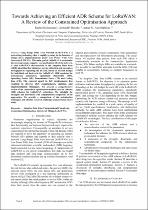 ResearchSpace
ResearchSpace
Towards achieving an efficient ADR scheme for LoRaWAN: A review of the constrained optimisation approach
JavaScript is disabled for your browser. Some features of this site may not work without it.
- ResearchSpace
- →
- Research Publications/Outputs
- →
- Conference Publications
- →
- View Item
| dc.contributor.author |
Kufakunesu, R

|
|
| dc.contributor.author |
Hancke, GP

|
|
| dc.contributor.author |
Abu-Mahfouz, Adnan MI

|
|
| dc.date.accessioned | 2022-01-24T06:58:50Z | |
| dc.date.available | 2022-01-24T06:58:50Z | |
| dc.date.issued | 2021-11 | |
| dc.identifier.citation | Kufakunesu, R., Hancke, G. & Abu-Mahfouz, A.M. 2021. Towards achieving an efficient ADR scheme for LoRaWAN: A review of the constrained optimisation approach. http://hdl.handle.net/10204/12231 . | en_ZA |
| dc.identifier.uri | http://hdl.handle.net/10204/12231 | |
| dc.description.abstract | Long Range Wide Area Network (LoRaWAN) is a networking technology that is rapidly growing in the Internet of Things (IoT) implementations under Low Power Wide Area Networks (LPWAN). The main goal of LoRaWAN is to optimise the coverage range, capacity, cost and battery life of the network. A vital LoRaWAN characteristic is the Adaptive Data Rate (ADR) algorithm that minimises energy utilisation and maximises throughput by regulating the bit rate, based on the link budget for individual end devices in the LoRaWAN. ADR regulates the transmission parameters, specifically Bandwidth (BW), Spreading Factor (SF), Transmission Power (TP) and Coding Rate (CR). The current spurt in IoT deployments has resulted in diverse QoS requirements, metrics, and implementation strategies. We present a comprehensive review of the constrained optimisation methods used to enhance ADR schemes for LoRaWAN technology. We highlight the strengths and drawbacks and computational complexity of the approaches. We provide a comparison of the optimisation techniques and identify research challenges and potential future study. | en_US |
| dc.format | Fulltext | en_US |
| dc.language.iso | en | en_US |
| dc.relation.uri | https://www.satnac.org.za/assets/documents/SATNAC%20-%20Programme%202021.pdf | en_US |
| dc.source | The Southern Africa Telecommunication Networks and Applications Conference (SATNAC2021) , Spier, Stellenbosch, Western Cape, South Africa, 1-23 November 2021 | en_US |
| dc.subject | Computational complexity | en_US |
| dc.subject | Constrained optimisation | en_US |
| dc.subject | Internet of Things | en_US |
| dc.subject | IoT | en_US |
| dc.subject | Long Range Wide Area Network | en_US |
| dc.subject | LoRaWAN | en_US |
| dc.subject | Low Power Wide Area Networks | en_US |
| dc.subject | LPWAN | en_US |
| dc.subject | Adaptive Data Rate | en_US |
| dc.subject | ADR | en_US |
| dc.title | Towards achieving an efficient ADR scheme for LoRaWAN: A review of the constrained optimisation approach | en_US |
| dc.type | Conference Presentation | en_US |
| dc.description.pages | 6 | en_US |
| dc.description.note | Paper presented at the Southern Africa Telecommunication Networks and Applications Conference (SATNAC 2021), Spier, Stellenbosch, Western Cape, South Africa, 1-23 November 2021 | en_US |
| dc.description.cluster | Next Generation Enterprises & Institutions | en_US |
| dc.description.impactarea | EDT4IR Management | en_US |
| dc.identifier.apacitation | Kufakunesu, R., Hancke, G., & Abu-Mahfouz, A. M. (2021). Towards achieving an efficient ADR scheme for LoRaWAN: A review of the constrained optimisation approach. http://hdl.handle.net/10204/12231 | en_ZA |
| dc.identifier.chicagocitation | Kufakunesu, R, GP Hancke, and Adnan MI Abu-Mahfouz. "Towards achieving an efficient ADR scheme for LoRaWAN: A review of the constrained optimisation approach." <i>The Southern Africa Telecommunication Networks and Applications Conference (SATNAC2021) , Spier, Stellenbosch, Western Cape, South Africa, 1-23 November 2021</i> (2021): http://hdl.handle.net/10204/12231 | en_ZA |
| dc.identifier.vancouvercitation | Kufakunesu R, Hancke G, Abu-Mahfouz AM, Towards achieving an efficient ADR scheme for LoRaWAN: A review of the constrained optimisation approach; 2021. http://hdl.handle.net/10204/12231 . | en_ZA |
| dc.identifier.ris | TY - Conference Presentation AU - Kufakunesu, R AU - Hancke, GP AU - Abu-Mahfouz, Adnan MI AB - Long Range Wide Area Network (LoRaWAN) is a networking technology that is rapidly growing in the Internet of Things (IoT) implementations under Low Power Wide Area Networks (LPWAN). The main goal of LoRaWAN is to optimise the coverage range, capacity, cost and battery life of the network. A vital LoRaWAN characteristic is the Adaptive Data Rate (ADR) algorithm that minimises energy utilisation and maximises throughput by regulating the bit rate, based on the link budget for individual end devices in the LoRaWAN. ADR regulates the transmission parameters, specifically Bandwidth (BW), Spreading Factor (SF), Transmission Power (TP) and Coding Rate (CR). The current spurt in IoT deployments has resulted in diverse QoS requirements, metrics, and implementation strategies. We present a comprehensive review of the constrained optimisation methods used to enhance ADR schemes for LoRaWAN technology. We highlight the strengths and drawbacks and computational complexity of the approaches. We provide a comparison of the optimisation techniques and identify research challenges and potential future study. DA - 2021-11 DB - ResearchSpace DP - CSIR J1 - The Southern Africa Telecommunication Networks and Applications Conference (SATNAC2021) , Spier, Stellenbosch, Western Cape, South Africa, 1-23 November 2021 KW - Computational complexity KW - Constrained optimisation KW - Internet of Things KW - IoT KW - Long Range Wide Area Network KW - LoRaWAN KW - Low Power Wide Area Networks KW - LPWAN KW - Adaptive Data Rate KW - ADR LK - https://researchspace.csir.co.za PY - 2021 T1 - Towards achieving an efficient ADR scheme for LoRaWAN: A review of the constrained optimisation approach TI - Towards achieving an efficient ADR scheme for LoRaWAN: A review of the constrained optimisation approach UR - http://hdl.handle.net/10204/12231 ER - | en_ZA |
| dc.identifier.worklist | 25196 | en_US |





